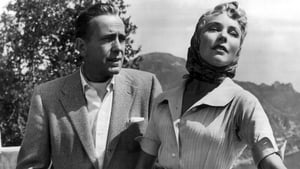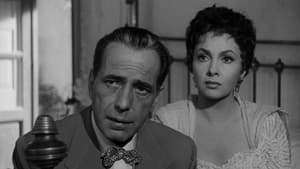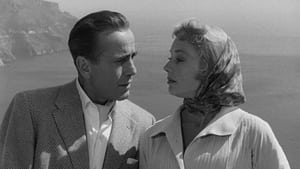Contact: [email protected]
Video Sources 0 Views
- Watch trailer
- Beat the Devil


Synopsis
Table of Contents
ToggleOld Hollywood Charm: Reviewing “Beat the Devil” (1953)

Introduction
“Beat the Devil” (1953) is a classic example of old Hollywood charm, blending elements of film noir with witty dialogue and a star-studded cast. Directed by John Huston, this film has garnered attention not only for its engaging storyline but also for its significance in the early colored films version. In this review, we will delve into the various aspects of “Beat the Devil,” from its direction and performances to its impact on the world of cinema.
Check The Full Colorized Movies List
Check Our Colorized Movies Trailer Channel
Understanding “Beat the Devil” (1953): Director, Cast, and Genre
Directed by the legendary John Huston, “Beat the Devil” boasts a cast of renowned actors, including Humphrey Bogart, Jennifer Jones, and Gina Lollobrigida. The film falls into the genre of adventure comedy, with elements of film noir woven throughout its narrative. Huston’s vision for the film was to create a lighthearted yet suspenseful story that would keep audiences on the edge of their seats from start to finish.
Exploring the World of “Beat the Devil” (1953): Plot and Characters
Set against the backdrop of post-World War II Italy, “Beat the Devil” follows a group of international adventurers as they embark on a journey to secure land rich in uranium deposits. The plot is filled with twists and turns, as the characters navigate betrayals, double-crossings, and unexpected alliances. At the center of it all is Billy Dannreuther (played by Humphrey Bogart), a charming yet enigmatic figure whose motives remain shrouded in mystery until the very end.
The Art of Film Colorization
One of the most notable aspects of “Beat the Devil” is its early colored version. This decision to release the film in colorized format was a bold move at the time, as black and white films were still prevalent in the industry. However, the use of color adds an extra layer of depth to the film’s visuals, bringing the lush landscapes of Italy to life and enhancing the overall viewing experience for audiences.
Early Colored Films: A Brief History
The release of “Beat the Devil” in colorized format marked a significant milestone in the history of cinema. While early experiments with color in film date back to the silent era, it wasn’t until the 1950s that colorization became more widely adopted. This shift allowed filmmakers to explore new creative possibilities and appeal to audiences who were increasingly drawn to the allure of color on the big screen.
“Beat the Devil” (1953) and Its Early Colored Version
The decision to release “Beat the Devil” in a colorized format was met with both excitement and skepticism from critics and audiences alike. Some praised the vibrant visuals and enhanced realism that color brought to the film, while others argued that it detracted from the gritty atmosphere and film noir aesthetic that “Beat the Devil” was known for. However, regardless of the debate surrounding its colorization, the film remains a testament to Huston’s innovative vision and the enduring appeal of classic Hollywood cinema.
The Debate Over Film Colorization
The controversy surrounding the colorization of black and white films continues to be a topic of debate in the film industry. While some argue that colorization allows audiences to experience classic films in a new light, others believe that it compromises the artistic integrity of the original work. Ultimately, the decision to colorize a film is a complex one, with considerations of artistic intent, historical context, and audience preferences all playing a role.
Examining “Beat the Devil” (1953) as an Early Colored Film
When viewed through the lens of its early colored version, “Beat the Devil” offers a unique glimpse into the evolution of cinema in the 1950s. The use of color adds a richness and vibrancy to the film’s visuals, allowing audiences to immerse themselves in the world of post-war Italy in a way that black and white film simply cannot replicate. While purists may argue that the film loses some of its noir-esque charm in color, there is no denying the impact that colorization has on the overall viewing experience.
Influence and Legacy: “Beat the Devil” (1953)’s Impact on Cinema
“Beat the Devil” may not have achieved the same level of commercial success as some of John Huston’s other films, but its influence on the world of cinema cannot be understated. The film’s bold experimentation with colorization paved the way for future innovations in filmmaking, inspiring filmmakers to push the boundaries of visual storytelling and explore new creative possibilities. Additionally, “Beat the Devil” has left an indelible mark on the adventure comedy genre, influencing countless films that followed in its wake.
Director’s Cinematic Legacy: Beyond “Beat the Devil” (1953)
John Huston’s legacy extends far beyond “Beat the Devil,” with the director leaving an indelible mark on the world of cinema through his groundbreaking work. Known for his masterful storytelling and ability to elicit powerful performances from his actors, Huston’s influence can be seen in the work of filmmakers around the world. From classics like “The Maltese Falcon” (1941) to “The Treasure of the Sierra Madre” (1948), Huston’s films continue to captivate audiences and inspire future generations of filmmakers.
Themes Explored in “Beat the Devil” (1953)
“Beat the Devil” explores a variety of themes, including deception, greed, and the pursuit of wealth. At its core, the film is a character-driven story that delves into the motivations and moral ambiguity of its protagonists. As the characters navigate a world filled with danger and intrigue, they are forced to confront their own desires and question the true meaning of success.
Reception and Controversy Surrounding “Beat the Devil” (1953)
Upon its release, “Beat the Devil” received mixed reviews from critics, with some praising its witty dialogue and ensemble cast, while others criticized its convoluted plot and uneven pacing. However, over time, the film has gained a cult following among cinephiles, who appreciate its unique blend of humor, suspense, and style. The decision to release the film in a colorized format sparked controversy among purists, but ultimately, it succeeded in introducing a new generation of viewers to the classic charm of “Beat the Devil.”
Where to Watch “Beat the Devil” (1953) Online
For those looking to experience the magic of “Beat the Devil,” the film is readily available on popular streaming platforms such as Amazon Prime, iTunes, and Google Play. Whether you choose to watch it in its original black and white format or in its early colored version, “Beat the Devil” promises to entertain and delight audiences with its timeless charm and captivating storytelling.
FAQs About “Beat the Devil” (1953)
Q: Who directed “Beat the Devil” (1953)?
A: “Beat the Devil” (1953) was directed by the renowned filmmaker John Huston, known for his contributions to classic cinema.
Q: What is the significance of “Beat the Devil” (1953) in film history?
A: “Beat the Devil” holds significance in film history for its experimentation with colorization during a time when black and white films were prevalent. It marked an early attempt to bring color to the big screen and paved the way for future innovations in filmmaking.
Q: How was the reception of “Beat the Devil” (1953) upon its release?
A: Upon its release, “Beat the Devil” received mixed reviews from critics. While some praised its witty dialogue and ensemble cast, others criticized its convoluted plot. However, over time, the film has gained a cult following among cinephiles.
Q: Is “Beat the Devil” (1953) available for streaming online?
A: Yes, “Beat the Devil” (1953) is available for streaming on various platforms such as Amazon Prime, iTunes, and Google Play. Both its original black and white version and the colorized version are accessible for viewers to enjoy.
Q: What are some common themes explored in “Beat the Devil” (1953)?
A: “Beat the Devil” (1953) explores themes such as deception, greed, and the pursuit of wealth. The film delves into the motivations and moral ambiguity of its protagonists as they navigate a world filled with danger and intrigue.
Q: Who are the main actors in “Beat the Devil” (1953)?
A: The main cast of “Beat the Devil” (1953) includes Hollywood legends such as Humphrey Bogart, Jennifer Jones, and Gina Lollobrigida, among others. Their performances contribute to the film’s enduring appeal and charm.
Q: What is the plot of “Beat the Devil” (1953)?
A: “Beat the Devil” (1953) follows a group of international adventurers as they embark on a journey to secure land rich in uranium deposits. The plot is filled with twists and turns, as the characters navigate betrayals, double-crossings, and unexpected alliances.
Q: How does colorization affect the viewing experience of “Beat the Devil” (1953)?
A: The decision to release “Beat the Devil” (1953) in a colorized format adds an extra layer of depth to the film’s visuals, bringing the lush landscapes of post-war Italy to life. While some purists may argue that colorization detracts from the film’s noir aesthetic, others appreciate the enhanced realism it brings to the story.
Q: What is John Huston’s cinematic legacy beyond “Beat the Devil” (1953)?
A: John Huston’s cinematic legacy extends far beyond “Beat the Devil” (1953). The director is known for his masterful storytelling and ability to elicit powerful performances from his actors. His influence can be seen in a wide range of films, from classics like “The Maltese Falcon” (1941) to “The Treasure of the Sierra Madre” (1948).
Q: What impact did “Beat the Devil” (1953) have on the adventure comedy genre?
A: “Beat the Devil” (1953) has left an indelible mark on the adventure comedy genre, influencing countless films that followed in its wake. Its blend of humor, suspense, and style continues to captivate audiences and inspire future generations of filmmakers.
Conclusion
In conclusion, “Beat the Devil” (1953) stands as a testament to the enduring legacy of classic Hollywood cinema and the innovative spirit of its filmmakers. From its captivating performances to its bold experimentation with colorization, the film continues to captivate audiences and inspire future generations of filmmakers. Whether viewed in its original black and white format or in its early colored version, “Beat the Devil” remains a timeless classic that continues to entertain and delight audiences around the world.














